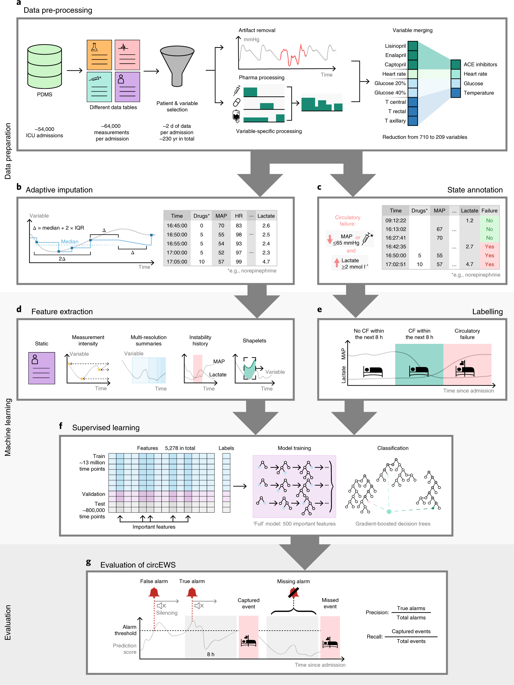Nature Medicine ( IF 58.7 ) Pub Date : 2020-03-09 , DOI: 10.1038/s41591-020-0789-4 Stephanie L Hyland 1, 2, 3, 4 , Martin Faltys 5 , Matthias Hüser 1, 4 , Xinrui Lyu 1, 4 , Thomas Gumbsch 6, 7 , Cristóbal Esteban 1, 4 , Christian Bock 6, 7 , Max Horn 6, 7 , Michael Moor 6, 7 , Bastian Rieck 6, 7 , Marc Zimmermann 1 , Dean Bodenham 6, 7 , Karsten Borgwardt 6, 7 , Gunnar Rätsch 1, 2, 3, 4, 7, 8 , Tobias M Merz 5, 9

|
Intensive-care clinicians are presented with large quantities of measurements from multiple monitoring systems. The limited ability of humans to process complex information hinders early recognition of patient deterioration, and high numbers of monitoring alarms lead to alarm fatigue. We used machine learning to develop an early-warning system that integrates measurements from multiple organ systems using a high-resolution database with 240 patient-years of data. It predicts 90% of circulatory-failure events in the test set, with 82% identified more than 2 h in advance, resulting in an area under the receiver operating characteristic curve of 0.94 and an area under the precision-recall curve of 0.63. On average, the system raises 0.05 alarms per patient and hour. The model was externally validated in an independent patient cohort. Our model provides early identification of patients at risk for circulatory failure with a much lower false-alarm rate than conventional threshold-based systems.
中文翻译:

使用机器学习早期预测重症监护室的循环衰竭
重症监护临床医生会收到来自多个监测系统的大量测量结果。人类处理复杂信息的能力有限,阻碍了对患者病情恶化的早期识别,大量监测警报导致警报疲劳。我们使用机器学习开发了一个预警系统,该系统使用具有 240 个患者年数据的高分辨率数据库集成了来自多个器官系统的测量值。它预测了测试集中 90% 的循环衰竭事件,其中 82% 提前超过 2 小时识别,导致受试者工作特征曲线下面积为 0.94,精确回忆曲线下面积为 0.63。平均而言,该系统会为每位患者每小时发出 0.05 个警报。该模型在一个独立的患者队列中进行了外部验证。











































 京公网安备 11010802027423号
京公网安备 11010802027423号